Anyone can immerse themselves in the world of mandalas with endless options—think simple beginner circles, wild floral petal bursts, and crisp geometric designs full of triangles and squares. Try zentangle doodle patterns, collage mandalas using scraps, beachy sand art with seashells, or digital creations with funky Procreate brushes. Some artists fill everyday objects like ice cream cones or hot air balloons with swirling mandala patterns. From sparkly metallics to animal themes, each idea packs creativity, surprise, and fun—curious minds are just getting started!
Key Takeaways
- Try a simple circle mandala using rings of dots, triangles, and contrasting colors for a stunning beginner-friendly design.
- Create a floral mandala by layering different petal shapes and experimenting with warm or cool color palettes for depth and mood.
- Draw geometric mandalas with triangles, squares, and overlapping shapes, using precision tools for symmetry and visual appeal.
- Personalize your mandala with meaningful symbols, such as the Hamsa or animals, to add unique storytelling and symbolism.
- Experiment with mixed media, collage, or metallic accents to add texture, dimension, and vibrant energy to your mandala artwork.
Simple Circle Mandala for Beginners
Circles are like the superheroes of the mandala world—they’re strong, simple, and always ready to save the day when your art needs a cool centerpiece.
Starting a simple circle mandala is easier than you might think. First, plop a small circle right in the middle of your paper; that’s your anchor, your home base in the world of drawing mandalas. Next, add a ring of patterns—maybe dots, tiny triangles, or zigzags—around that center.
Make sure each pattern is spaced out evenly, because symmetry is the secret sauce in Mandala Art Ideas. Keep expanding outward, ring by ring, adding new shapes as you go. For extra wow, try contrasting colors or shading. A compass helps with perfect circles, but eyeballing it makes things more fun!
Floral Mandala With Petal Patterns
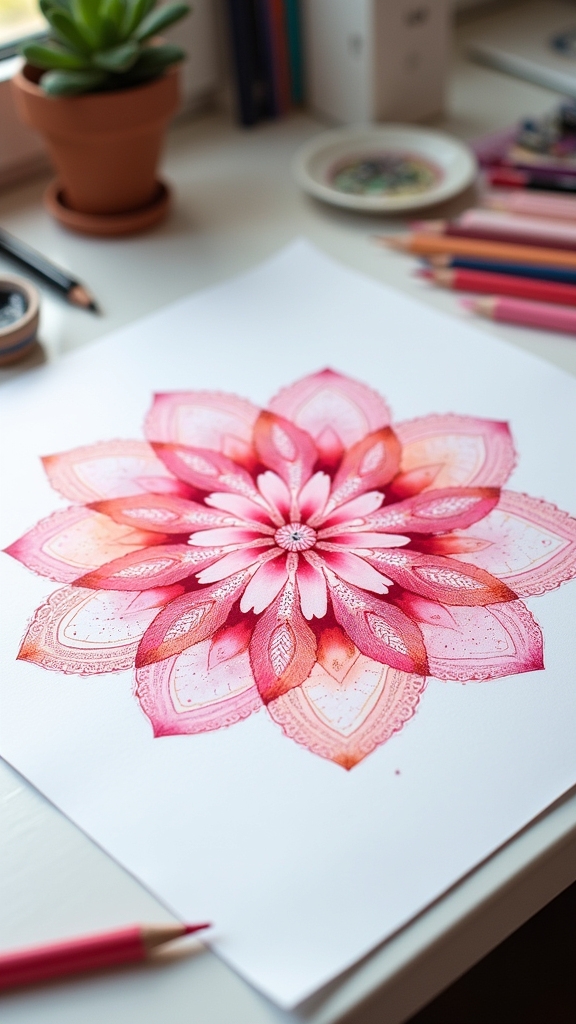
Floral mandalas get even more eye-catching when you start layering different petal motifs, almost like building a magical garden right on your paper.
Playing around with petal shapes and sizes keeps things fresh, and picking colors—whether bold and warm or cool and calm—totally changes the mood.
It’s kind of like being the boss of your own flower shop, but way less messy than dealing with real dirt.
Layering Petal Motifs
Petals, with their soft curves and endless shapes, bring a burst of life to mandala art. When it comes to drawing a floral mandala, layering petal motifs is like stacking secrets—each ring reveals more, pulling you away from the outside world and into the heart of your art drawing.
Start by sketching a simple central circle, then add a ring of basic petals all around. Next, draw more layers, each with petals that change in size or shape, but always keep things balanced and symmetrical. This trick creates depth and makes your design pop.
Try out different art supplies, like gel pens or water-soluble oil pastels, for extra texture. Layer by layer, your mandala becomes more alive, almost blooming right from the page.
Color Choices for Florals
Once the petal layers start stacking up and the mandala begins to bloom, it’s time for the magic of color to take over.
Color choices can totally change the mood of your floral mandala. Warm tones like reds, oranges, and yellows burst with energy, making your piece feel like a sunbeam. Cooler palettes—think blues and greens—give off a chill, peaceful vibe.
Want your petals to pop? Try using contrasting colors for the petals and background. For extra depth, blend colors in a gradient—imagine petals fading from deep purple to soft pink!
If you’re hunting for ideas and inspiration, experiment with wild color combos until you find a style that’s totally you.
Geometric Mandala With Triangles and Squares
Geometry lovers, get ready to geek out—mandalas made with triangles and squares are where math meets magic. These shapes aren’t just for your geometry homework; they’re the building blocks for some seriously cool mandala designs!
By mixing triangle variations with different square orientations, artists can create a wild sense of order and movement that catches the eye. Precision tools like a compass or ruler help keep those lines sharp and the symmetry on point.
But don’t stop there—experiment with overlapping shapes for extra depth, like a geometric puzzle that keeps you guessing. For the final touch, color contrasts work wonders. Bright blues against fiery reds or cool greens with sunny yellows make your triangles and squares leap off the page, practically buzzing with energy!
Mandala Using the Flower of Life Design
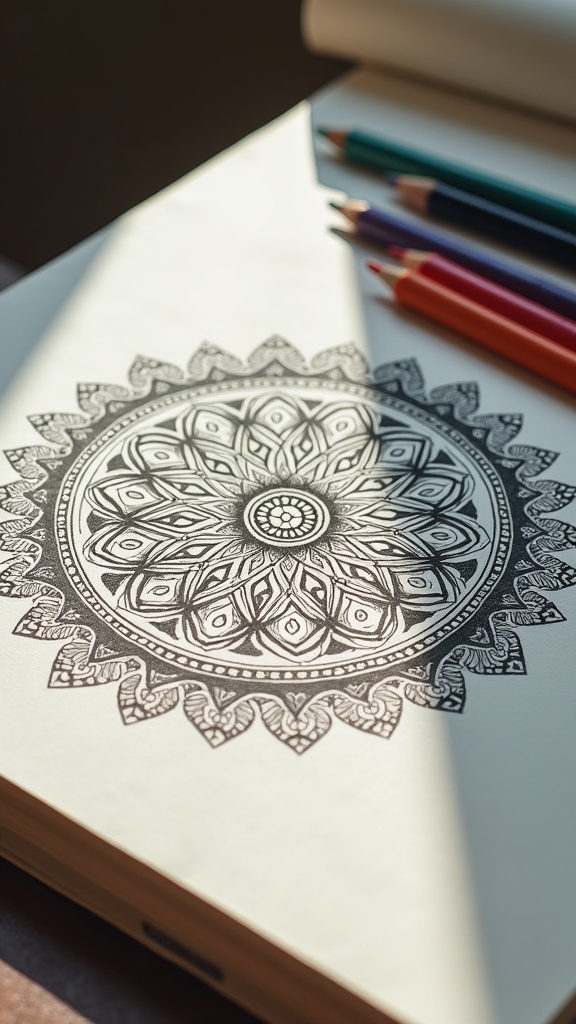
The Flower of Life might look complicated at first, but its origins go way back and its pattern is actually pretty simple to build step by step.
Drawing this mandala starts with just one circle, and before you know it, you’re connecting a web of shapes that artists say holds deep meanings about life and the universe.
People use this design not just because it looks cool, but also because it’s packed with symbolism and can be a powerful tool for creativity and reflection.
Origins of Flower of Life
Patterns can be more than just cool designs—they can actually tell stories about ancient cultures and the mysteries of life itself. One especially mind-blowing example is the Flower of Life. This pattern, made of overlapping circles, goes way back in history and pops up in places like ancient Egyptian temples and even the Indus Valley civilization. That’s some serious historical significance!
Different cultures have their own cultural interpretations of the Flower of Life, but many see it as a symbol of geometric symbolism and interconnectedness—basically, everything is connected, like your Wi-Fi but way older and way deeper.
In mandala art, this design isn’t just for looks; it stands for wholeness and unity, reflecting the balance and harmony that runs through all of nature.
Step-by-Step Drawing Guide
A lot of people might look at a mandala and think, “Whoa, that looks impossible to draw!”—but actually, anyone can create a stunning Flower of Life mandala with just a bit of patience and the right steps.
Start with a small circle right in the center of your paper. Grab a compass—no, not the one for finding north, the drawing kind—and begin adding overlapping circles, keeping them neat so your geometric patterns line up perfectly.
As more layers build up, a beautiful, web-like design appears, hinting at ancient flower symbolism.
Don’t forget, you can jazz it up! Use artistic techniques like shading, outlining, or adding tiny details inside the shapes. Experiment with colors—maybe cool blues or fiery reds—to make your mandala pop!
Symbolic Meanings and Uses
Interconnectedness practically bursts out of the Flower of Life mandala—seriously, it’s like a cosmic web showing how everything is linked together.
This pattern, made of overlapping circles, isn’t just cool to look at; it’s loaded with spiritual significance. Across tons of cultures, people use the Flower of Life to represent creation, life cycles, and even the universe’s grand design.
Drawing it in a mandala isn’t just doodling—it’s about inviting healing energy and mindfulness into your art. Artists love exploring sacred geometry this way, and let’s be real, it feels pretty magical.
Plus, you can totally make it your own! Try mixing in your favorite colors or personal symbols for a splash of personal expression while still capturing that universal vibe.
Zentangle-Inspired Mandala Patterns
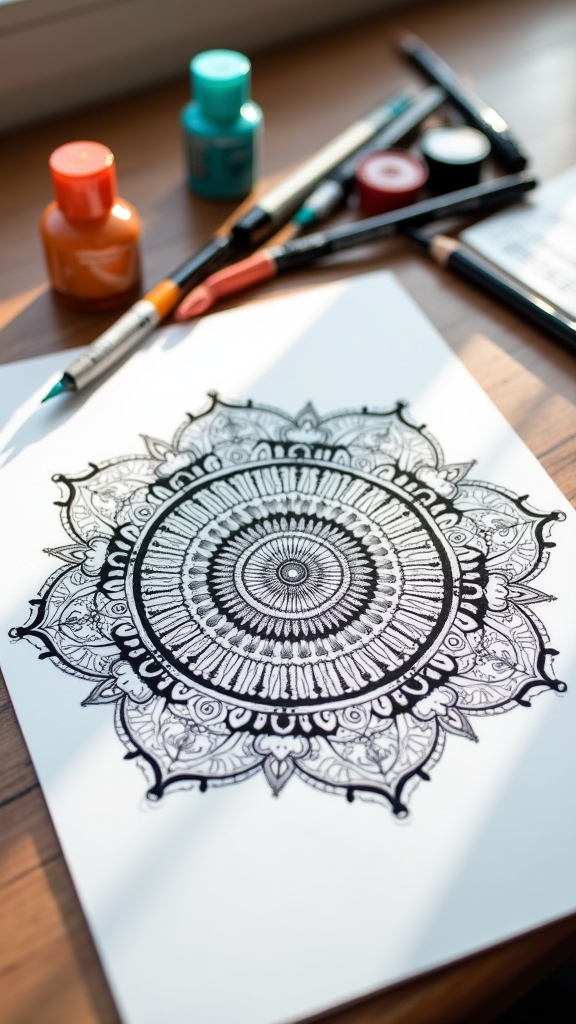
Even if your doodles tend to wander off the page, zentangle-inspired mandala patterns are here to prove that art doesn’t need to be perfect to be awesome.
These mandalas combine intricate doodle techniques with circular designs, letting anyone jump into creative flow exploration without worrying about making a mistake. Every squiggle, swirl, and pattern you add helps your brain relax—hello, zentangle mindfulness benefits!
The best part? Anyone can do it. Whether you’re using a pencil, a stack of fancy pens, or even crayons, zentangle mandalas welcome all skill levels.
Artists get to play with line weights, textures, and wild ideas, ending up with a piece that’s both calming and seriously cool. Who knew doodling in circles could be this rewarding?
Minimalist Black and White Mandala
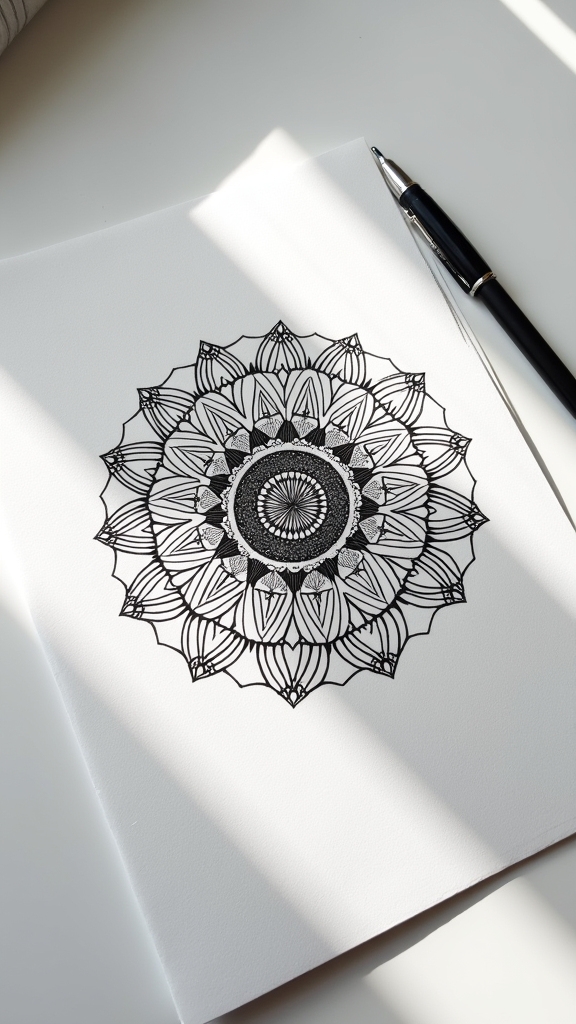
Minimalist black and white mandalas show how much beauty can come from keeping things simple, focusing all the attention on bold lines and the spaces between them.
By playing with thick and thin lines, artists can make patterns that pop without needing a single drop of color—talk about drama!
It’s a bit like turning up the contrast on a photo, where every shape stands out and even the empty spaces seem full of energy.
Embracing Simplicity in Design
A black pen, some white paper, and a big idea—sometimes that’s all it takes to make something seriously cool.
Minimalist black and white mandalas are all about embracing simplicity in design. By sticking to clean lines and basic shapes, artists can focus on design principles like balance and repetition without getting sidetracked by a million colors.
Minimalist patterns make it easier to see how everything fits together, and there’s a kind of artistic mindfulness that kicks in when you’re drawing each line with purpose. Even just playing around with different pen thicknesses or doodling on textured paper can totally change the vibe.
Plus, this style is super beginner-friendly, which means anyone can jump in and start mastering mandalas, one simple stroke at a time.
Exploring Line and Contrast
When artists ditch the rainbow and stick with just black and white, something surprising happens—the humble line becomes a total superstar. Minimalist black and white mandalas let every swirl and zigzag shine, all thanks to clever line thickness techniques. Thin lines whisper, while thick ones shout, giving the designs amazing contrast.
Artists use contrast balance strategies to keep things from looking too busy or too boring—kind of like deciding if your pizza needs more cheese or less sauce. Texture enhancement methods, like stippling or cross-hatching, add depth and make flat paper come alive.
The best part? You only need a pen or pencil to get started. Drawing these mandalas isn’t just cool, it’s calming—each repeated line is like a mini meditation session.
Mandala Art on Black Paper With Gel Pens
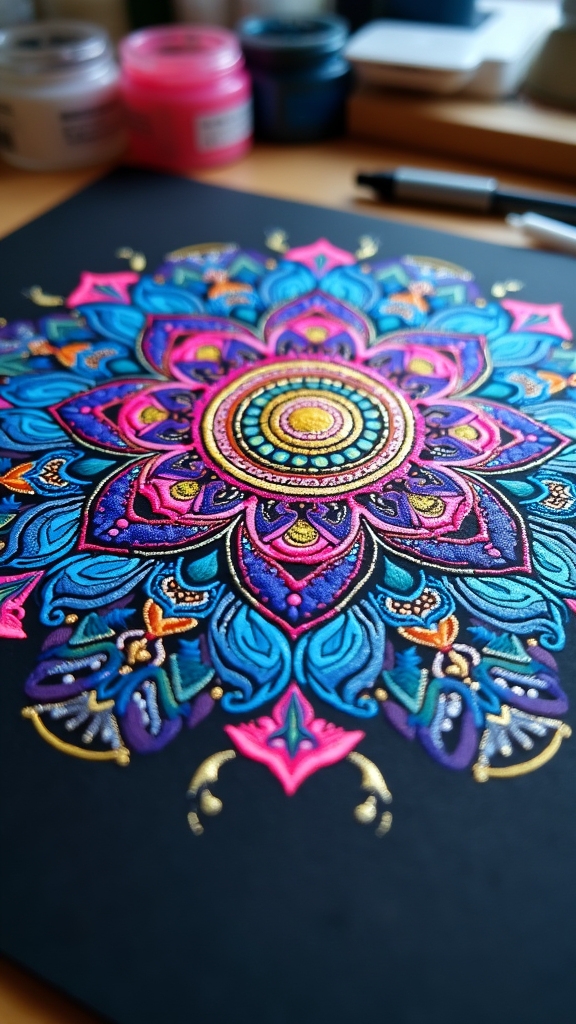
Imagine grabbing a stack of jet-black paper and watching bright, colorful gel pens burst to life with every line you draw—that’s the magic of mandala art on black backgrounds.
Black paper advantages are huge: every stroke shines brighter and every color feels electrifying. Gel pen techniques become extra fun, especially with metallic, glitter, or opaque finishes that shimmer and pop.
If you’re dreaming of extra detail, try mandala layering—start with a white gel pen for outlines, then add layers of color for a 3D effect!
Ready to try? Here are some tips:
- Choose gel pens with different finishes for unique effects.
- Sketch outlines with white gel pen first.
- Layer colors to create depth and dimension.
- Experiment with patterns for personalized designs.
Animal-Themed Mandala Compositions
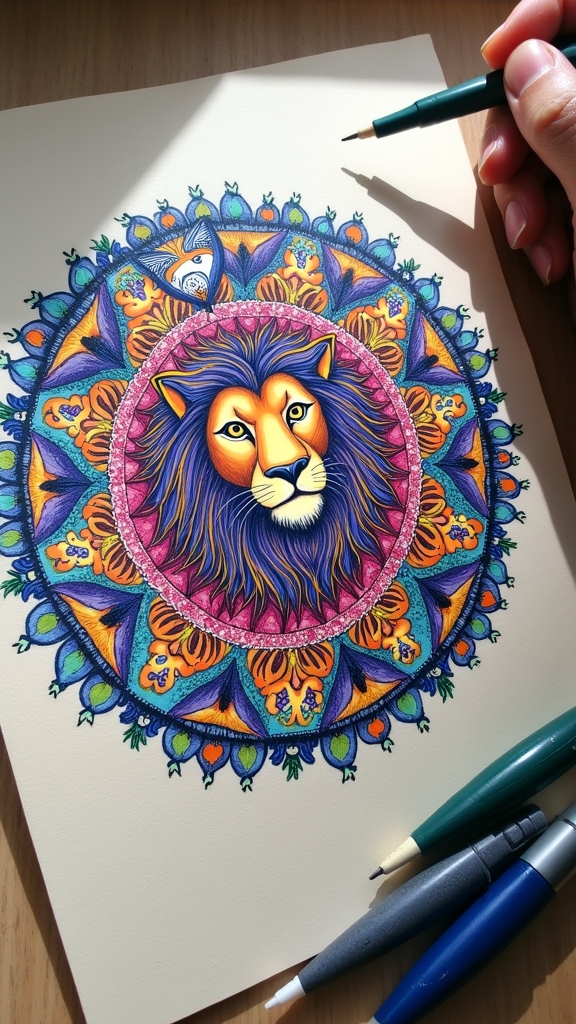
Colors glowing on black paper are awesome, but what if those swirling mandala patterns started to look like animals? Imagine an owl’s big eyes made of repeating circles, or an elephant’s trunk twisting right out of a spiral.
Animal-themed mandala compositions are all about animal symbolism exploration—every creature has a special meaning. Elephants might stand for strength, owls for wisdom, and butterflies for transformation.
Artists mix mandala design techniques, like sacred geometry and floral details, to make these animals pop. Adding bold, contrasting colors? That’s where color psychology influence comes in, letting each animal’s vibe shine through.
Digital tools like Procreate make it even easier, letting you play with colors and shapes until your lion roars—or at least looks super cool.
Mandala With Embedded Nature Scenes
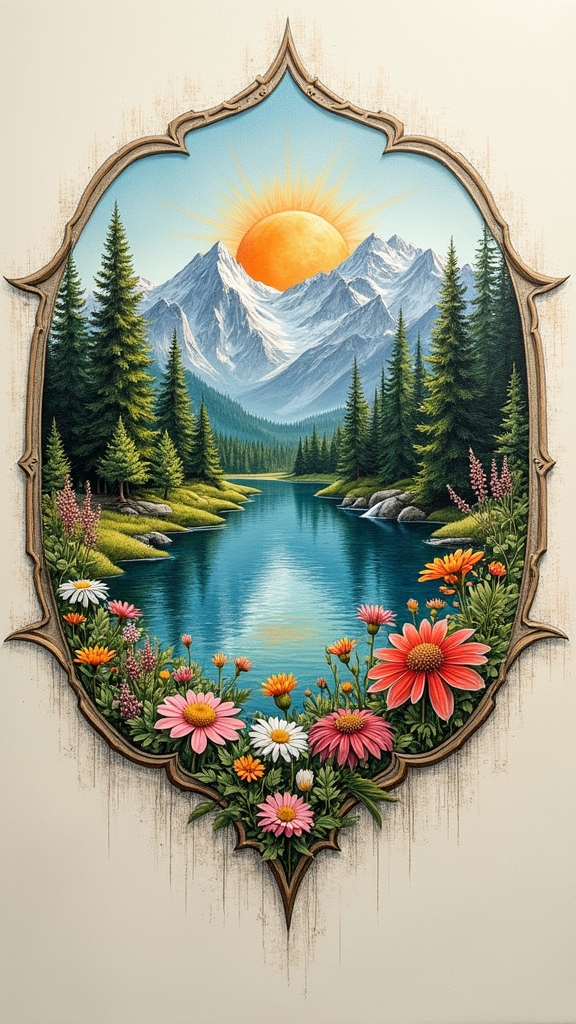
Imagine a mandala where snow-capped mountains rise up inside perfect circles, or twisting forests blend right into the swirling patterns, making the whole thing feel wild and alive.
Adding water—maybe a rushing river or a gentle lake—brings in movement and cool colors that can totally change the mood.
These nature scenes don’t just look awesome, they give every mandala a story, like a tiny world waiting to be explored.
Mountains Within Mandala Circles
Mountains and mandalas might seem like an odd pair at first, but put them together and the result is seriously awesome.
When artists embed mountain scenes inside mandala circles, they blend the structured beauty of geometry with the wild, epic vibe of nature. The secret? Play around with mountain symbolism—think strength, adventure, or the journey of self-discovery.
Layering the mountain shapes within the mandala (hello, mandala layering!) keeps everything symmetrical and eye-catching. To really make the scene pop, experiment with color depth by shading the peaks and valleys.
If you want to try this yourself, follow these tips:
- Start with a circular mandala base.
- Layer mountain shapes symmetrically.
- Use mixed media for texture.
- Shade for color depth and drama!
Forests Blending With Patterns
While mountain mandalas bring that wild, rugged vibe, there’s a whole different kind of magic when forests get mixed into the patterns.
Imagine trees, leaves, and tiny wildlife peeking out from behind swirling geometric shapes—suddenly, it’s like a secret world hiding in plain sight. Forest symbolism adds layers of meaning, representing growth, peace, and a deep connection to nature.
By using mandala techniques—like starting with a light sketch, then building up patterns around the forest scene—artists can create super cool, balanced compositions.
Natural textures and all those different shades of green? They make the forest look almost alive! Want to level up? Try water-soluble oil pastels or gel pens for rich, vibrant layering. It’s like magic for your drawing!
Water Elements in Designs
Water works wonders in mandala designs, bringing a chill, peaceful vibe to the whole piece. Just imagine waves, ripples, or even a flowing stream swirling around in a circle—suddenly, it’s like you’re looking into a magical pond!
There’s a ton of water symbolism significance here, like renewal and transformation. Artists can really make these aquatic patterns inspiration pop by mixing in cool blues and aquas, adding to the tranquility in design.
Want some ideas? Try these:
- Frame a scene of a lake or river right in the center of your mandala.
- Sneak in fish, lotus flowers, or even watery reflections for extra meaning.
- Use layering to make water look deep and mysterious.
- Mix in ripple or wave patterns for movement and flow.
Mandala Featuring the Hamsa Symbol
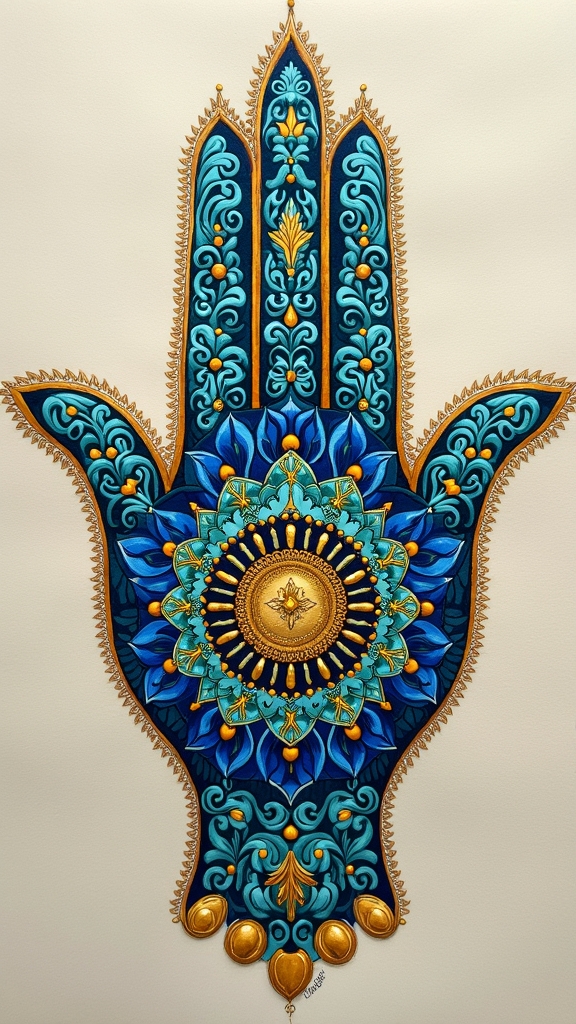
A Hamsa mandala isn’t just cool to look at—it’s packed with meaning, too. The Hamsa, shaped like a hand, stands out in mandala art thanks to its protective vibes and its role in blessing people. When artists play with Hamsa symbolism significance, the design isn’t just pretty; it’s powerful. There’s a lot of room for mandala color experimentation here—think fiery reds or chill blues, all changing the mood. And when you throw in sacred geometry fusion, the results can be mind-blowing! The patterns wrap around the Hamsa, balancing the inside and outside worlds in a single drawing. Check out this table for inspiration ideas:
| Hamsa Style | Color Choices | Geometry Fusion |
|---|---|---|
| Classic | Warm reds | Circles |
| Modern | Cool blues | Triangles |
| Floral | Gold accents | Stars |
| Abstract | Monochrome | Hexagons |
| Intricate | Rainbow hues | Spirals |
Mandala Incorporating Hands or Personal Symbols
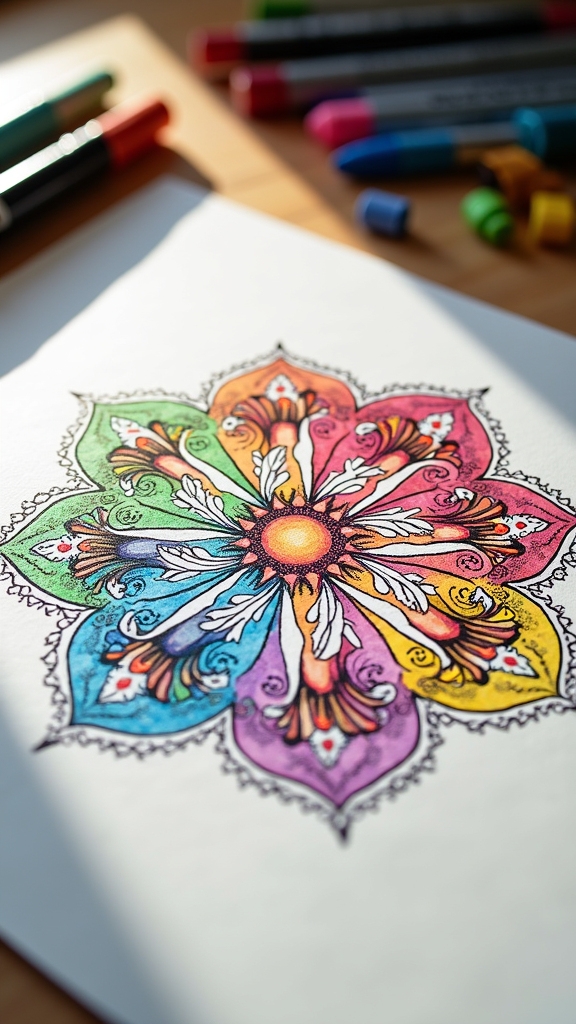
Adding hands or personal symbols to a mandala is like sneaking your own secret code into the design, letting your story peek out from the patterns.
Hand motifs can mean all sorts of things—maybe you’re reaching for your dreams, or just showing off how creative you are (literally, with your own hands).
Expressing Identity Through Symbols
When it comes to making a mandala truly your own, there’s nothing quite as powerful as slipping in a personal symbol—like the outline of a hand or something that just screams “you.”
It’s kind of like leaving your signature at the heart of your art, but way cooler and way more meaningful. Personal symbols take mandalas beyond just pretty patterns—they turn them into a form of symbolic storytelling.
Every doodle can represent a piece of your personal narrative, and it’s a fantastic way to show off your creative expression. Here are some reasons to add personal symbols to your mandala:
- They showcase your unique identity.
- They encourage deep self-reflection.
- They connect your art to cultural stories.
- They turn mandalas into meditative, meaningful creations.
Hand Motifs in Mandalas
Symbols are cool, but hands really crank up the personality in a mandala. When artists engage in hand symbolism exploration, they’re not just drawing fingers and palms—they’re adding a secret code to their artwork.
Hands can stand for protection, strength, or blessings, especially when using the famous hamsa hand. This isn’t just about looking awesome, either. Including creative hand designs in a mandala can give the whole thing a unique vibe and actually help the artist feel more connected to their emotions.
It’s like giving your mandala a heartbeat! Drawing hands isn’t easy, but experimenting with different styles makes the process fun. Each hand motif adds layers of meaning, making the mandala feel personal and super special every time.
Personal Stories in Design
Ever wonder what happens when a mandala stops being just a pattern and starts telling your story? That’s exactly what happens when people add hands or personal symbols into their designs.
Instead of just cool swirls and shapes, these mandalas start to feel like snapshots of a personal journey or secret map of self-discovery. For anyone itching to try creative expression that’s totally unique, here’s how it works:
- Choose a symbol—like your hand, a favorite animal, or something that means a lot to you.
- Place it in the center or weave it through the mandala’s patterns.
- Let each shape or line represent a memory, dream, or goal.
- Reflect on your design—it’s meditative and might surprise you with new insights!
Mandala With Warm vs. Cool Color Palettes
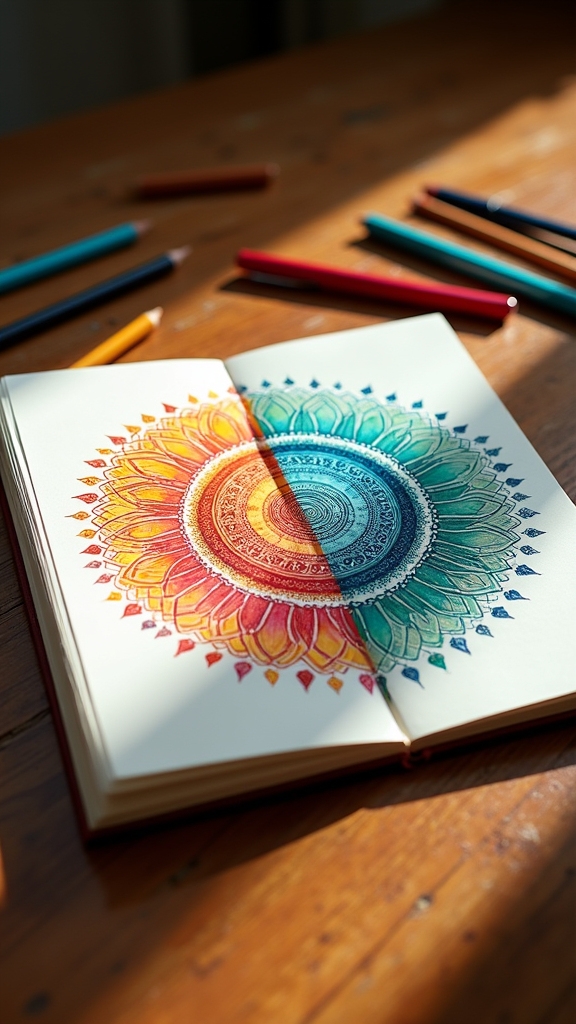
Plenty of artists find themselves torn between warm and cool color palettes when creating mandalas, and honestly, it’s a pretty exciting choice to make.
Warm color impact is all about energy—think reds, oranges, and yellows that practically sizzle on the page. These shades can turn any mandala into something bold, lively, and impossible to ignore.
On the flip side, cool color benefits are super calming. Blues, greens, and purples make mandalas feel peaceful, like a deep breath for your eyes.
But who says you have to pick just one? Contrasting color techniques let artists mix both worlds, making mandalas pop with extra depth and interest.
Mandala Using Water-Soluble Oil Pastels
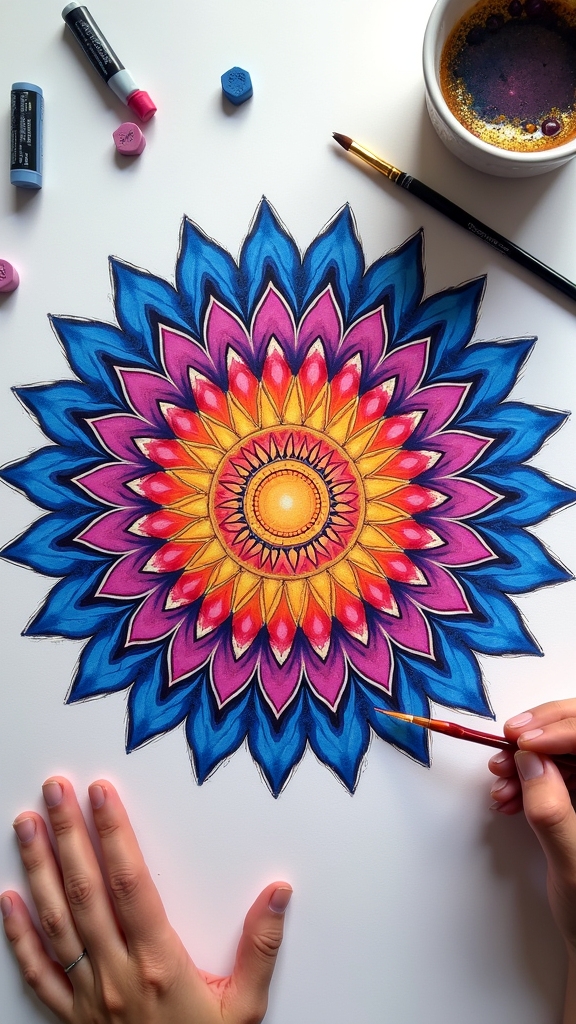
After all that talk about color palettes, here’s where things really get interesting—water-soluble oil pastels bring a whole new game to mandala drawing.
Imagine the magic of watercolor techniques mixed with the boldness of pastels! Mandalas pop with vibrant colors and wild blending effects when you add a bit of water. It’s like watching art transform right before your eyes.
Layering pastel applications gives your designs extra depth and texture, making them seem almost 3D. If you’re ready to get creative, try these steps:
- Sketch your mandala design lightly in pencil.
- Apply pastels dry for sharp lines or fill in areas.
- Use a wet brush to blend and create watercolor effects.
- Layer more colors for richer blending effects and detail.
Cool, right?
Mandala Inspired by Sacred Geometry
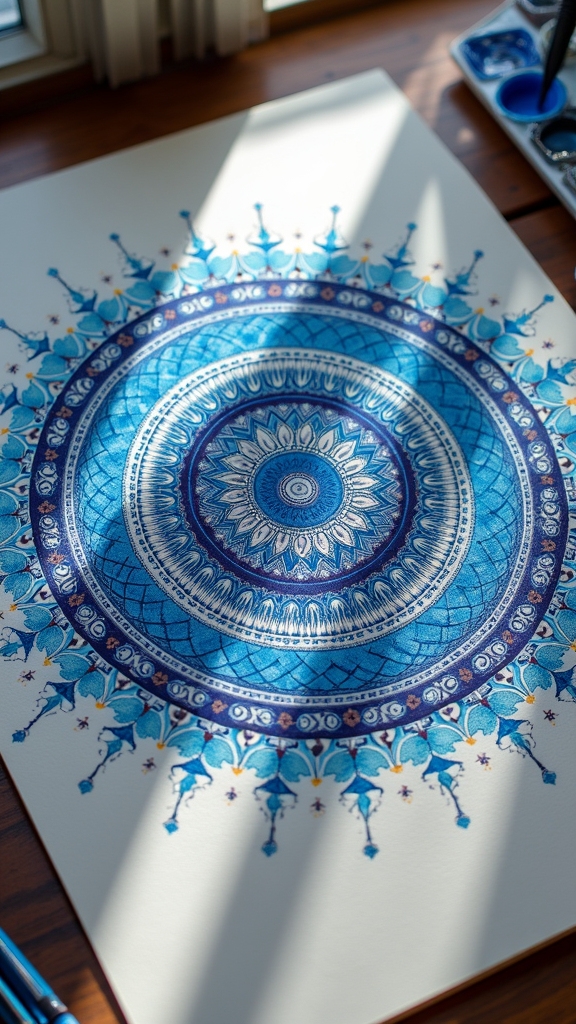
Sacred geometry brings a whole new level of “wow” to mandala art, and it’s not just about drawing shapes—it’s about revealing hidden patterns that seem almost magical.
When creating a mandala inspired by sacred geometry, artists tap into ancient sacred symbolism, using patterns like the flower of life, which looks like a bunch of perfectly overlapping circles. It’s like math and art got together for a secret handshake!
By focusing on symmetry and proportion, these mandalas shine with geometric harmony, making everything feel balanced and calm. Some artists even sneak in personal symbols, giving their designs a secret story.
Making these mandalas can spark a real spiritual connection, too, as the patterns often mirror cool things found in nature—like crystals or the way leaves grow.
Krishna Mandala: Spiritual Motifs and Figures
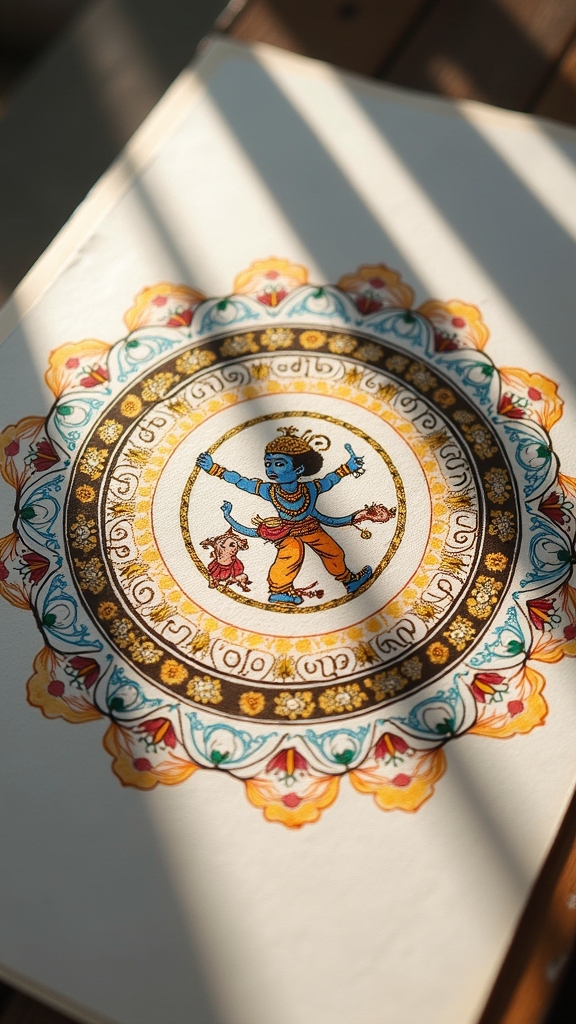
Color bursts from every corner in a Krishna mandala, making it feel like a celebration on paper. These lively mandalas aren’t just pretty—they’re packed with meaning! Krishna symbolism pops up everywhere, from swirling flutes to sneaky peacock feathers, each detail telling a story about Krishna’s divine love and playful spirit.
It’s like every line is dancing to a secret melody! Artists use all kinds of artistic techniques, like layering colors or mixing different materials, to give their work depth and make the patterns almost jump off the page.
Feeling inspired? Try these ideas:
- Draw flutes or lotus flowers for instant Krishna vibes.
- Add peacock feathers to boost spiritual energy.
- Experiment with bold, joyful colors.
- Share your creation online for instant feedback!
Mandala With Floral and Leafy Borders
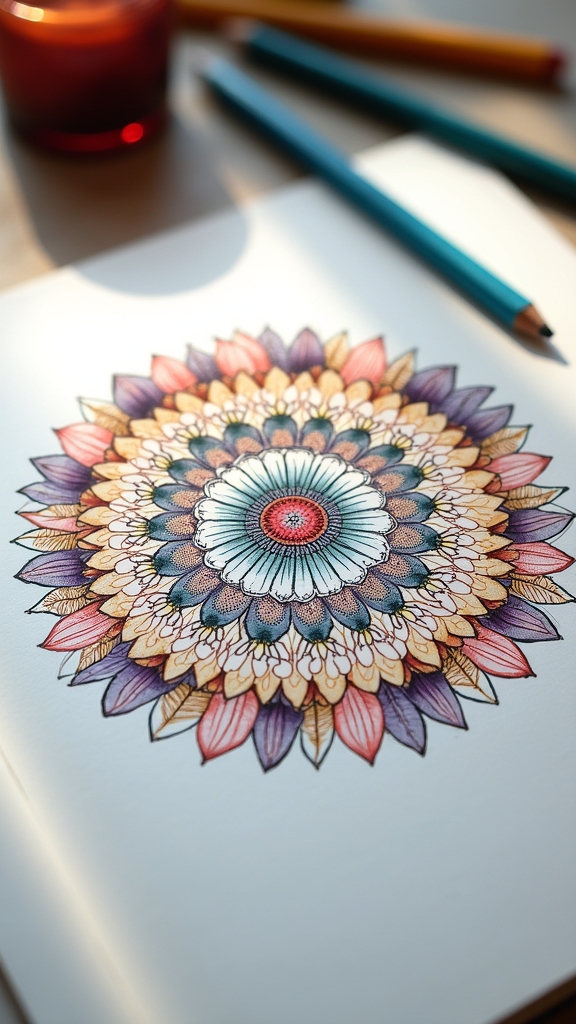
Imagine a mandala where the edge is bursting with flowers and leaves, almost like it’s throwing a garden party right on your page! Mandala artists love adding leafy patterns and petals because they bring in floral symbolism—think growth, peace, and harmony. Using different mandala techniques, you can mix bold sunflowers, delicate roses, and wild vines, letting your creativity run wild. Want it to pop? Try warm reds and yellows for the flowers, cool blues and greens for the leaves. It’s like color magic! Adding your favorite flowers makes your mandala feel super personal, almost like a secret code. Drawing leafy borders is also calming, repeating shapes like nature’s own lullaby.
| Element | Artistic Effect |
|---|---|
| Floral shapes | Symbolize growth |
| Leafy patterns | Add movement/detail |
| Warm/cool colors | Create visual depth |
| Personal symbols | Make art unique |
Mandala Designed With Metallic Accents
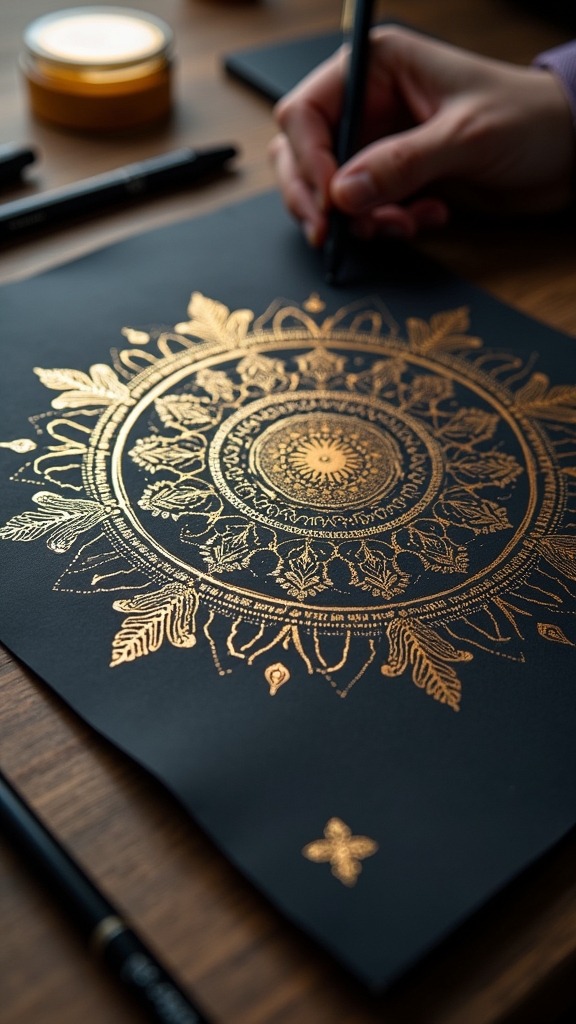
When it comes to making a mandala shine—literally—metallic accents are the secret weapon. Adding metallic color combinations like gold, silver, and bronze can seriously step up your mandala game, giving it that wow factor.
If you want your mandala to look extra fancy and almost magical, try these steps:
- Use metallic gel pens or acrylic paint for those shiny highlights and tiny, detailed patterns.
- Play with visual contrast techniques—think bold colors next to metallics to make everything stand out.
- Experiment with mandala texture layering by mixing smooth metallic lines with bumpy or dotted patterns.
- Draw your mandala on dark paper; the metallics will pop and shimmer, almost like stars in the night sky.
Your artwork will totally sparkle!
Collage Mandala With Mixed Media Elements
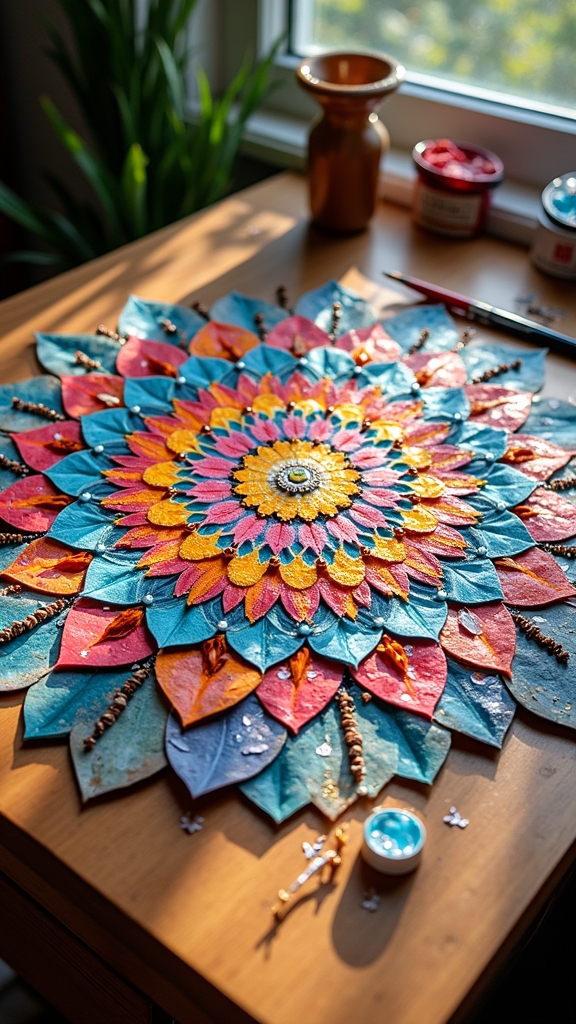
A whole world of creativity opens up with collage mandalas made from mixed media elements.
With collage techniques, artists layer paper, fabric, or even old photographs, building a textured masterpiece that feels alive. Mixed media—think splashes of watercolor, bold lines from gel pens, or pastel smudges—add bursts of color and energy, almost like the mandala is jumping off the page.
If someone’s feeling eco-friendly (or just loves magazine clippings), recycled scraps can bring quirky patterns and a story to every section.
Trying out different glues, like decoupage, not only holds everything together but can give the mandala a shiny finish.
Every collage mandala becomes a wild ride of artistic expression, letting artists show off their unique style and favorite textures.
Beach Sand or Seashell Mandala Creation
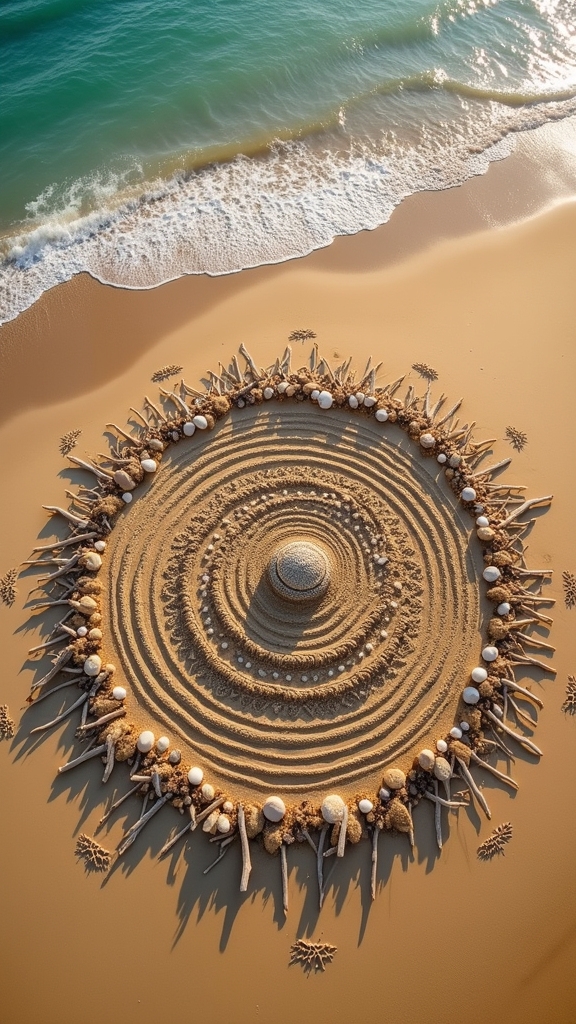
Even though sand and seashells might seem like simple stuff you’d find on a walk by the ocean, they can actually turn into the coolest art supplies ever for making mandalas.
With some creative beach mandala techniques, anyone can transform a flat surface—like a sandy patch or even a big piece of cardboard—into a stunning piece of art. By using seashell arrangements and playing with natural textures, each mandala becomes unique and eye-catching.
For those ready to try, here’s how to get started:
- Pick a flat spot with plenty of space for your design to spread out.
- Outline your mandala shape using beach sand.
- Add seashells, stones, or driftwood for layers and cool details.
- Snap photos of your creation before the tide or wind takes it away!
Digital Mandala Art With Procreate
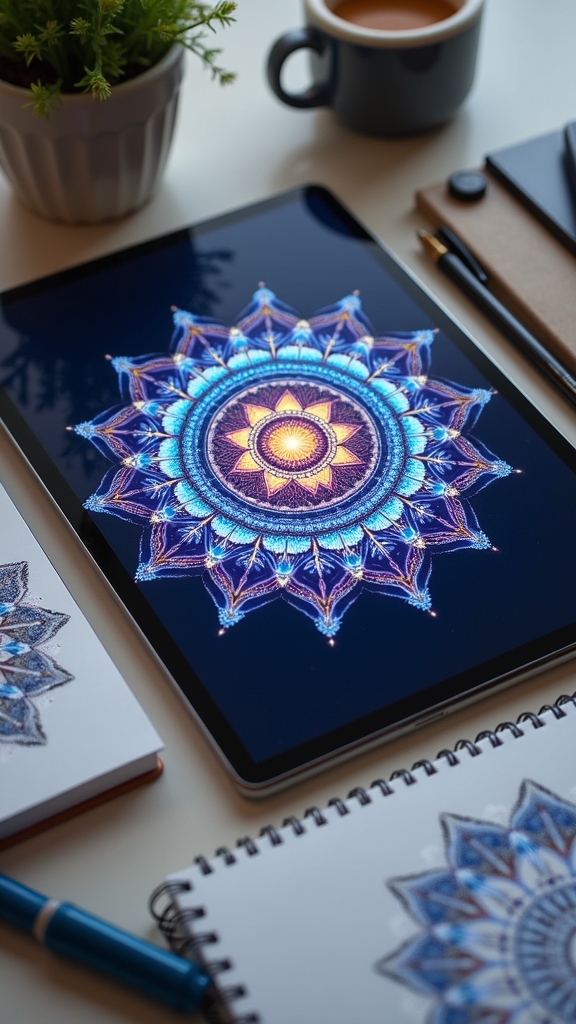
Immerse yourself in the colorful world of digital mandala art—and yes, it’s as cool as it sounds! With Procreate, anyone can become a digital mandala master, thanks to its crazy-versatile tools. The fun starts with digital mandala techniques—imagine drawing one line and watching it magically repeat into perfect patterns using the symmetry tool applications. Procreate brush customization lets artists craft thick or thin, smooth or textured lines, making every mandala unique. Layers help you tweak details without wrecking the whole piece, and custom color palettes bring wild ideas to life. Plus, exporting your art in hi-res means you can show off your creations everywhere. Check out how these features stack up:
| Procreate Feature | Mandala Benefit | Fun Factor |
|---|---|---|
| Symmetry Tool | Perfect balance | Super satisfying |
| Brush Customization | Unique lines & textures | Totally creative |
| Layers | Easy editing | Stress-free fixes |
| Custom Color Palettes | Vibrant, personal colors | Color explosion |
Mandala Within Everyday Objects (e.g., Hot Air Balloon, Ice Cream Cone)
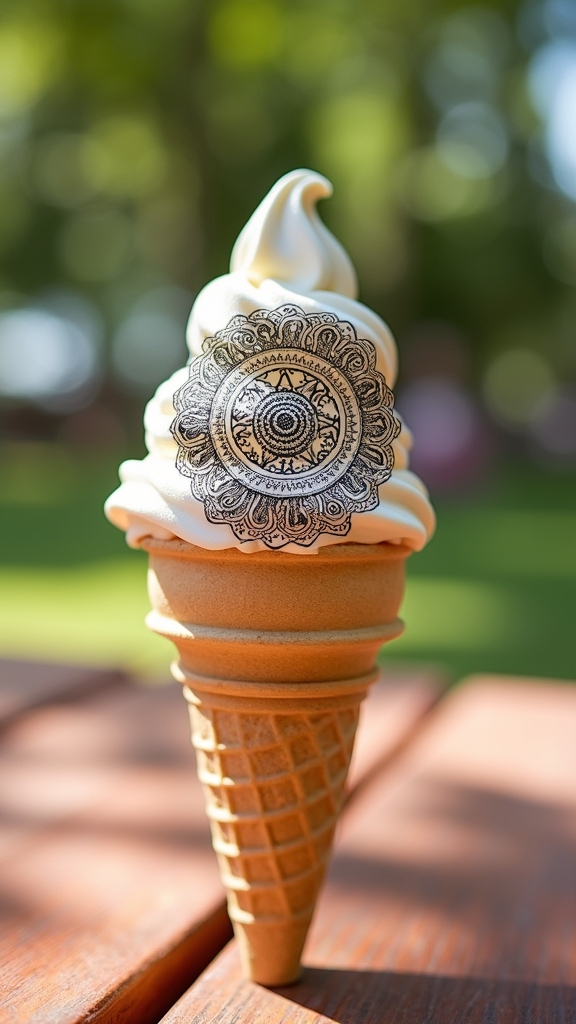
Sometimes, the coolest mandala ideas hide in plain sight—like inside a scoop of ice cream or floating above in a hot air balloon.
Everyday object mandalas turn ordinary things into spectacular bursts of color and pattern. Imagine swirling designs inside an ice cream cone, or a hot air balloon filled with intricate shapes, each layer telling a different story.
Creative color layering lets artists make those patterns pop, while mixed media techniques—like mixing gel pens with watercolors—add serious wow-factor.
Want to try it? Here’s how:
- Pick an everyday object—maybe your favorite dessert or something from your room.
- Sketch its outline lightly.
- Fill the shape with layered mandala patterns and bold colors.
- Try mixed media for extra texture and depth.
Frequently Asked Questions
What Is the Cultural Significance of Mandalas in Different Traditions?
Mandalas symbolism varies across cultures, representing unity, wholeness, and cosmic order. Cultural interpretations appear in Hinduism, Buddhism, and Native American traditions, where mandalas play key roles in spiritual practices, meditation, and rituals for personal and collective transformation.
How Can Mandala Drawing Support Mindfulness or Meditation Practices?
Mandala drawing can support mindfulness or meditation practices by encouraging mindful breathing, enhancing focus, and allowing creative expression. This meditative process often leads to stress relief, as individuals become absorbed in repetitive patterns and calming, intentional movements.
Are There Recommended Techniques for Transferring Mandala Designs to Fabric?
When considering transfer methods for mandala designs to fabric, individuals often use tracing paper, carbon paper, or water-soluble pens. Fabric choices and design scaling are important factors, ensuring clarity and compatibility with the intended textile and project size.
What Are Common Mistakes Beginners Make When Drawing Mandalas?
Common mistakes beginners make when drawing mandalas include improper proportional spacing, frequent symmetry errors, and unsuitable tool selection. These issues often result in uneven patterns and inconsistent designs, highlighting the importance of careful planning and choosing appropriate drawing instruments.
How Do I Preserve or Frame My Finished Mandala Artwork?
Preserving artwork requires using acid-free materials and avoiding direct sunlight. Framing techniques such as matting and UV-protective glass help maintain quality. Display options include shadow boxes or traditional frames, ensuring the mandala remains vibrant and protected over time.
Conclusion
With these 21 mandala drawing ideas, anyone can jump in and start creating—no fancy tools or art degree required. Mandalas aren’t just pretty; they’re actually super relaxing to draw, kind of like doodling but with a cooler pattern. Whether someone goes wild with colors or keeps it simple, each mandala turns out unique. So, grab some paper, maybe a snack, and let creativity spin. Who knows, the next masterpiece could be just a circle away!


Leave a Reply